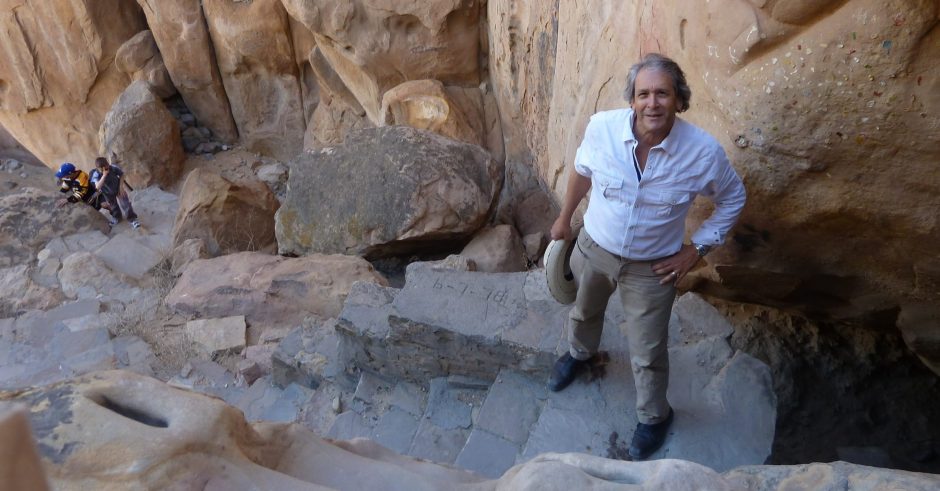The literature (or at least some of it) indicates Chaco Canyon was abandoned around 1150, with the migration route following the “Great North Road,” which is visible with satellite imagery. This migration resulted in the Aztec complex, 60 km due north of Chaco, which was begun around 1110 (according to A History of the Ancient Southwest, by Steve Lekson, Santa Fe: SAR Press, 2008 — a book I highly recommend ).
For a few intervening decades, however, the Las Vegas of the 900 years ago had moved to an intermediate spot on the San Juan River, on the outskirts of what is now Bloomfield, New Mexico. There is speculation that agriculture at Chaco had become too difficult during a period of drought. Clearly there is ample water for drinking and irrigation on the banks of the San Juan, which is fed by snow melt from the San Juan Mountains in southern Colorado. Look at the image below grabbed from Google Maps. The Salmon Ruins are located on US-64, just west of Bloomfield. North of town are the Aztec Ruins, on the Animas River.
Below four-lane US-64 is the Salmon visitor center and ruin, surrounded by small houses, trailers, and industrial uses. The San Juan River is in the lower right corner of the image.
The experience is vastly different from Paquime or Chaco. One gets a sense he’s in somebody’s backyard while also visiting an important archaeological site. Another big difference is that San Juan Ruins are operated by San Juan County. Its visitor center is large and attractive and the exhibits are more extensive than those available in the current visitor center configuration at Chaco. However; one gets a powerful sense that the place is lightly visited. When I arrived around 11:00 a.m., I was visitor number one for that Saturday. The sole staff member on hand was a bearded man with Vietnam veteran regalia on his car and a pack of Camels in his shirt pocket. Admission to the park, which also includes George Salmon’s pioneer homestead and examples of various Indian dwellings, is $3.00 for adults.
The excavation of Salmon (pronounces more like Salomon brothers than like the fish) was excavated fairly recently — between 1972 and 1978. The San Juan County Museum Association provides an excellent guide to the site, which includes descriptions at 18 markers along a pathway. Markers are also provided to identify various native plants.
As an example, the description for Marker 1, says the following:
You are standing at the northeastern corner of the Pueblo. The back wall is 120 meters (394 feet) in length and was three stories high. The exterior eastern wall was approximately 50 meters (164 feet) long and western exterior wall was approximately 56 meters (183 feet) long. Current research suggests that the pueblo’s back wall was laid out in alignment with astronomical observatins that were based on a Lunar Standstill.
The construction of the wall represents a hallmark of Chacoan wall construction: core and veneer masonry. Using sandstone that was specifically cut to fit, masons used constructions methods unique to their culture and exercised great skill at their craft. The location known to be the source for the majority of stone materials for Salmon is a quarry about three miles north of the site. Exactly where the timbers used to build were harvested is uncertain, but is likely they were procured (in) the Chuska or the La Plata Mountains, nearly 50 miles away. It is possible that the beams were floated down-river, but, more likely, they were carried by hand to the site.
And here is what one sees at Marker 1:
According to William Morgan’s Ancient Architecture of the Southwest, Salmon contained 290 rooms, compared to the 800 rooms at Pueblo Bonito, perhaps the largest of Chaco Canyon’s structures.
It was lonely at Salmon, but hardly quiet. The din cocks crowing and traffic on the adjacent highway reminds the visitor that he’s in the midst of a bustling gas-fueled economy.
Given the noise and the visual pollution, the experience is quite a bit different from serene experience at either Chaco or Paquime. Granted I was only there for a quick run-through, but the timeless sense of spirituality this jaded observer felt at Paquime and Chaco proved a bit more elusive here. The experience was a bit closer to that of the Tlatelolco site in a residential area of Mexico City. (See below.) My stomach was rumbling and I was thinking way too much about coffee and food, so I made back through the foggy Camel-generated haze in the visitors center to the parking lot and psychologically speaking aimed the Malibu back in that same due-north direction to Aztec.








Dear Mr. Shieldhouse,
I am writing on behalf of the University of Colorado Museum of Natural History. I would like to use one of your Salmon Ruin shots in an exhibit that will be placed in our Map Library here on campus. We are a non-profit academic institution, and the display case is in a public area, and free to the public and students of the University of Colorado. Please contact me at christina.mcclellan@colorado.edu.
Thank you for your time and help,
Christina
I sent you a reply by email. Sorry for the delay. Haven’t been working on the blog at all.
did i reply to you already? of course you can use my shots!